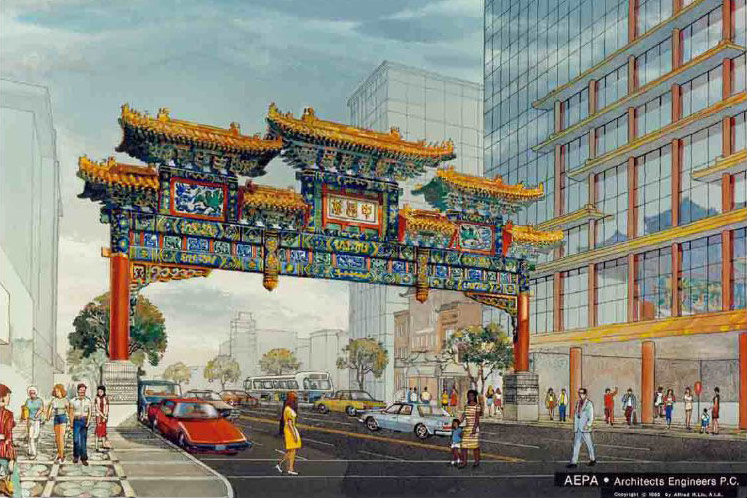Read the original press release on Smithsonian Newsdesk
The Smithsonian Asian Pacific American Center (APAC) will present its first museum exhibition in a decade with Sightlines: Chinatown and Beyond, opening September 7 at the Smithsonian American Art Museum. Guest curated by Sojin Kim from the Center for Folklife and Cultural Heritage, the exhibition considers Washington, D.C.’s Chinatown as both a geographical focal point and a historical nexus, inviting audiences to take a closer look into Asian Americans’ contributions to the cultural and built environment of the nation’s capital.
The exhibition’s free opening festival is scheduled for Saturday, September 7, 11:30 a.m. to 4 p.m., in the Kogod Courtyard and will feature martial arts presentations, visual arts demonstrations, hands-on craft activities, a discussion with local Asian American chefs, and music and dance performances, including DJ sets. Representatives from local Asian American community organizations will talk with visitors about their work and histories in the area. This event is co-presented by APAC and the Smithsonian American Art Museum.
Sightlines features more than 120 objects, including photographs, architectural drawings, sketchbooks and ephemera drawn from the Smithsonian and local private collections. Videos for the exhibition were produced by Charlie Weber, Albert Tong, and a team at the Center for Folklife and Cultural Heritage. The exhibition considers creative practices and civic engagement, efforts to preserve and reinterpret heritage and tradition, and the building of communities and coalitions across racial and ethnic boundaries in Washington from the 1970s to the present.
“The exhibition underscores the vital role Asian Americans have played in shaping the communities, landscapes and cultures in Washington, D.C.,” said Yao-Fen You, APAC’s acting director. “We are grateful to the Smithsonian American Art Museum for providing the venue for the presentation of some of these compelling and often overlooked stories. The museum’s location in D.C.’s Chinatown is perfect as an entry point for visitors to learn about our capital city from different perspectives.”

Curated with support from Adriel Luis, APAC’s curator of digital and emerging practice, and Mia Owens, curatorial assistant and former Folklife intern, Sightlines offers new vantage points on the cultural imprint of Asian Americans on the city through three narratives explored in the show’s three primary sections:
- “Making Place” illuminates efforts to increase Chinatown’s visibility in the 1970s and ’80s, a period in which its survival was threatened. Highlights of this section include architectural drawings by Alfred H. Liu, who designed the Friendship Arch marking the entrance to Chinatown, and archival materials related to the Eastern Wind Collective, a grassroots organization devoted to building pan-ethnic solidarity among Asian ethnic groups. While Liu sought to safeguard Chinatown by creating a newly built environment that would emphasize its Asian heritage and attract international visitors, Eastern Wind’s strategy looked to the past to reinforce a sense of community.
- “Transforming Tradition” examines Asian martial arts as vehicles for self-expression and community building. Several schools and styles of martial arts flourished in Washington during the ’70s, resulting in the formation of a racially and ethnically diverse lineage of practitioners that continues today. Clothing, badges, trophies, photographs, and artwork that chart the fascinating rise, spread and impact of martial arts in the city and beyond are highlighted in this section. It also tells the story of Simba Dojang, a tae kwon do school whose successes earned it the accolade of “the winningest team.”
- “Visualizing Identity” centers on the work of MISS CHELOVE (a.k.a. Cita Sadeli), a contemporary Washington artist who draws inspiration from her Indonesian mother’s heritage and uses the tools and methods of graffiti and street art to claim space for multiple communities. Throughout the city, MISS CHELOVE’s vibrant murals celebrate her multicultural identity and her deep community connections that aim to encourage reflection on personal and communal obligations to cultural traditions. Original artwork and objects from the artist’s personal collection offer insight into how she connects the dots across the communities with whom she identifies.
The exhibition, which was designed by the award-winning firm TSKP x IKD and will run through November 30, 2025, will have a companion website featuring education resources and a digital “Atlas” with content on a range of other sightlines into Asian American histories and experiences in the city. Recurring public programming will be produced in conjunction with the exhibition during its run.
Sightlines is supported by a grant from the Henry Luce Foundation and made possible through support from the Terra Foundation for American Art and the Surdna Foundation. The exhibition has also received federal funding from the Asian Pacific American Initiatives Pool, administered by the Smithsonian Asian Pacific American Center; the Smithsonian American Women’s History Initiative Pool, administered by the Smithsonian American Women’s History Museum; and the Smithsonian Collections Care Initiative Pool, administered by the National Collections Program.
About the Smithsonian Asian Pacific American Center
The Asian Pacific American Center, established in 1997, ensures the comprehensive representation and inclusion of Asian Americans, Native Hawaiians, and Pacific Islanders across the Smithsonian’s collections, research, exhibitions, and programs. Through education initiatives, publications, and public programs, APAC provides new avenues to document, celebrate, and share the rich and diverse history, art, and culture of Asian American, Native Hawaiian, and Pacific Islander communities.


